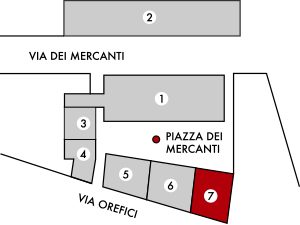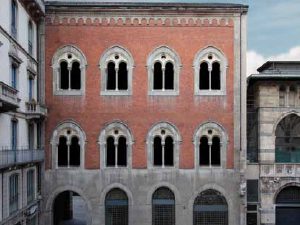Il portico della “Ferrata” venne costruito su iniziativa del podestà Beccario Beccaria nel 1325. Era anticamente  uno spazio chiuso da alte inferriate dove si tenevano le aste dei beni dei mercanti che avevano dichiarato fallimento. Il luogo fu per secoli legato alla vicina Casa del Podestà che si estese fino al di sopra del Portico della Ferrata, che era anche uno dei sei accessi alla Piazza del Broletto. Insieme al portico del Palazzo della Ragione fu dal 1480, come ci ricorda anche una lapide posta successivamente sul suolo davanti alla Ferrata, il “luogo designato alla riunione dei mercanti”. Dove oggi è collocato il pozzo si trovava la cosiddetta “pietra della sculacciata”, un masso liscio dove i mercanti falliti venivano condotti e costretti all’umiliazione di sbattervi il sedere nudo. In caso di contumacia, i mercanti, e tutti coloro che fossero venuti meno alla pubblica fiducia legata al loro operare (anche i notai per
uno spazio chiuso da alte inferriate dove si tenevano le aste dei beni dei mercanti che avevano dichiarato fallimento. Il luogo fu per secoli legato alla vicina Casa del Podestà che si estese fino al di sopra del Portico della Ferrata, che era anche uno dei sei accessi alla Piazza del Broletto. Insieme al portico del Palazzo della Ragione fu dal 1480, come ci ricorda anche una lapide posta successivamente sul suolo davanti alla Ferrata, il “luogo designato alla riunione dei mercanti”. Dove oggi è collocato il pozzo si trovava la cosiddetta “pietra della sculacciata”, un masso liscio dove i mercanti falliti venivano condotti e costretti all’umiliazione di sbattervi il sedere nudo. In caso di contumacia, i mercanti, e tutti coloro che fossero venuti meno alla pubblica fiducia legata al loro operare (anche i notai per  esempio), venivano rappresentati in dipinti infamanti sulla facciata di alcuni palazzi della piazza. All’inizio del 1800 un sistema di permute tra il Ministero della Giustizia e la Camera di Commercio, portò gli uffici di quest’ultima anche alla Ferrata, dove il portico venne chiuso e venne costruita una scala ellittica che conduceva alla Corte di cassazione. Promotrice di diversi progetti di ampliamento, la Camera di Commercio nel 1872 affidò all’architetto Giovan Battista Sormani l’aggiunta di un ulteriore piano per dare spazio al Museo commerciale. Nel 1906 Pietro Somarini ne ristrutturò completamente l’interno per adattarlo a sede della Banca Rasini: della Ferrata rimase solo la faccia.
esempio), venivano rappresentati in dipinti infamanti sulla facciata di alcuni palazzi della piazza. All’inizio del 1800 un sistema di permute tra il Ministero della Giustizia e la Camera di Commercio, portò gli uffici di quest’ultima anche alla Ferrata, dove il portico venne chiuso e venne costruita una scala ellittica che conduceva alla Corte di cassazione. Promotrice di diversi progetti di ampliamento, la Camera di Commercio nel 1872 affidò all’architetto Giovan Battista Sormani l’aggiunta di un ulteriore piano per dare spazio al Museo commerciale. Nel 1906 Pietro Somarini ne ristrutturò completamente l’interno per adattarlo a sede della Banca Rasini: della Ferrata rimase solo la faccia.
The Portico della Ferrata was built on the initiative of the podestà Beccario Beccaria in 1325. Formerly it was a space  closed off by high railings where auctions of the goods of merchants who had declared bankruptcy were held. For centuries it was closely linked to the neighbouring Casa del Podestà, which extended over the Portico della Ferrata, also one of the six entrances to Piazza del Broletto. Together with the loggia of Palazzo della Ragione, it was, from 1480 onwards — as a tablet subsequently placed on the ground in front of the Portico recalls — ‘the place designated for meetings of merchants’. A well is now located on the site of the so-called pietra della sculacciata (‘spanking stone’), a smooth block of stone on which bankrupt merchants were humiliated by being obliged to sit with bare backsides. If they were absent, these merchants — and all those who betrayed the public’s trust in their work (including, for example, notaries) — were portrayed in defamatory paintings on the façades of some of the buildings in the square. At the beginning of the nineteenth century a series of exchanges between the Ministry of Justice and the Chamber of Commerce caused the latter’s offices also to be moved to the Portico della Ferrata, which was then closed and an elliptical staircase was built giving access to the Court of Appeal. In 1872, as the promoter of the various extension projects, the Chamber of Commerce commissioned the architect Giovan Battista Sormani to add another floor for the Commercial Museum. In 1906 Pietro Somarini completely rebuilt the interior as the premises of the Banca Rasini: only the façade of the Portico della Ferrata remained.
closed off by high railings where auctions of the goods of merchants who had declared bankruptcy were held. For centuries it was closely linked to the neighbouring Casa del Podestà, which extended over the Portico della Ferrata, also one of the six entrances to Piazza del Broletto. Together with the loggia of Palazzo della Ragione, it was, from 1480 onwards — as a tablet subsequently placed on the ground in front of the Portico recalls — ‘the place designated for meetings of merchants’. A well is now located on the site of the so-called pietra della sculacciata (‘spanking stone’), a smooth block of stone on which bankrupt merchants were humiliated by being obliged to sit with bare backsides. If they were absent, these merchants — and all those who betrayed the public’s trust in their work (including, for example, notaries) — were portrayed in defamatory paintings on the façades of some of the buildings in the square. At the beginning of the nineteenth century a series of exchanges between the Ministry of Justice and the Chamber of Commerce caused the latter’s offices also to be moved to the Portico della Ferrata, which was then closed and an elliptical staircase was built giving access to the Court of Appeal. In 1872, as the promoter of the various extension projects, the Chamber of Commerce commissioned the architect Giovan Battista Sormani to add another floor for the Commercial Museum. In 1906 Pietro Somarini completely rebuilt the interior as the premises of the Banca Rasini: only the façade of the Portico della Ferrata remained.